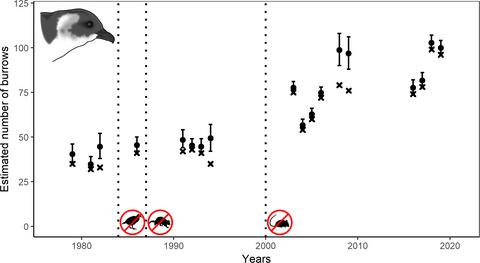当前位置:
X-MOL 学术
›
Anim. Conserv.
›
论文详情
Our official English website, www.x-mol.net, welcomes your
feedback! (Note: you will need to create a separate account there.)
Population growth estimates of a threatened seabird indicate necessity for additional management following invasive predator eradications
Animal Conservation ( IF 2.8 ) Pub Date : 2019-05-27 , DOI: 10.1111/acv.12516 J. H. Fischer 1 , G. A. Taylor 2 , R. Cole 3 , I. Debski 2 , D. P. Armstrong 4 , H. U. Wittmer 1
Animal Conservation ( IF 2.8 ) Pub Date : 2019-05-27 , DOI: 10.1111/acv.12516 J. H. Fischer 1 , G. A. Taylor 2 , R. Cole 3 , I. Debski 2 , D. P. Armstrong 4 , H. U. Wittmer 1
Affiliation

|
© 2019 The Zoological Society of London The eradication of invasive predators from islands is a successful technique to safeguard seabird populations, but adequate post-eradication monitoring of native species is often lacking. The Whenua Hou Diving Petrel (Pelecanoides whenuahouensis; WHDP) is a recently-described and ‘Critically Endangered’ seabird, restricted to Codfish Island (Whenua Hou), New Zealand. Invasive predators, considered the major threat to WHDP, were eradicated on Codfish Island in 2000. However, estimates of WHDP population size and trends remain unknown, hindering assessments of the success of the eradications. We collated intermittent burrow counts (n = 20 seasons) conducted between 1978 and 2018. To estimate the population growth rate (λ) before and after predator eradications, we used log-linear models in a Bayesian hierarchical framework while retrospectively accounting for differences in detection probabilities among burrow counts, due to differences in effort, marking and timing. The number of WHDP burrows was estimated at 40 (36–46) in 1978 and 100 (97–104) in 2018. The pre-eradication λ was estimated at 1.023 (0.959–1.088), while the post-eradications λ was estimated at 1.017 (1.006–1.029). The WHDP population appears to be increasing, yet the rate of increase is low compared to other Procellariiformes following predator eradications. The comparatively low post-eradication λ, combined with an apparent lack of change between pre- and post-eradication λ, indicates that additional threats might be limiting WHDP population growth and that further conservation management is required. The continuation of affordable and simple, albeit imperfect, monitoring methods with retrospective corrections facilitated the assessment of invasive predator eradications outcomes and should guide future management decisions. An abstract in Te Reo Māori (the Māori language) can be found in Appendix S1.
中文翻译:

受威胁海鸟的种群增长估计表明,在消灭入侵性捕食者后需要进行额外管理
© 2019 The Zoological Society of London 从岛上消灭入侵捕食者是保护海鸟种群的成功技术,但通常缺乏对本地物种的充分消灭后监测。Whenua Hou 潜水海燕 (Pelecanoides whenuahouensis; WHDP) 是一种最近被描述的“极度濒危”海鸟,仅限于新西兰鳕鱼岛 (Whenua Hou)。被认为是对 WHDP 的主要威胁的入侵性捕食者于 2000 年在鳕鱼岛被根除。然而,对 WHDP 种群规模和趋势的估计仍然未知,阻碍了对根除成功的评估。我们整理了 1978 年至 2018 年间进行的间歇性洞穴计数(n = 20 个季节)。为了估计捕食者灭绝前后的人口增长率 (λ),我们在贝叶斯分层框架中使用了对数线性模型,同时回顾性地解释了由于工作量、标记和时间的差异,洞穴计数之间检测概率的差异。1978 年 WHDP 洞穴的数量估计为 40 (36-46) 个,2018 年为 100 (97-104) 个。 根除前 λ 估计为 1.023 (0.959-1.088),而根除后 λ 估计为1.017 (1.006–1.029)。WHDP 种群似乎在增加,但与其他捕食者根除后的 Procellariiformes 相比,增长率较低。根除后 λ 相对较低,加上根除前和根除后 λ 之间明显没有变化,表明额外的威胁可能限制了 WHDP 种群的增长,需要进一步的保护管理。继续采用经济实惠且简单但不完善的监测方法,并进行回顾性修正,有助于评估入侵性捕食者根除结果,并应指导未来的管理决策。Te Reo Māori(毛利语)的摘要可以在附录 S1 中找到。
更新日期:2019-05-27
中文翻译:

受威胁海鸟的种群增长估计表明,在消灭入侵性捕食者后需要进行额外管理
© 2019 The Zoological Society of London 从岛上消灭入侵捕食者是保护海鸟种群的成功技术,但通常缺乏对本地物种的充分消灭后监测。Whenua Hou 潜水海燕 (Pelecanoides whenuahouensis; WHDP) 是一种最近被描述的“极度濒危”海鸟,仅限于新西兰鳕鱼岛 (Whenua Hou)。被认为是对 WHDP 的主要威胁的入侵性捕食者于 2000 年在鳕鱼岛被根除。然而,对 WHDP 种群规模和趋势的估计仍然未知,阻碍了对根除成功的评估。我们整理了 1978 年至 2018 年间进行的间歇性洞穴计数(n = 20 个季节)。为了估计捕食者灭绝前后的人口增长率 (λ),我们在贝叶斯分层框架中使用了对数线性模型,同时回顾性地解释了由于工作量、标记和时间的差异,洞穴计数之间检测概率的差异。1978 年 WHDP 洞穴的数量估计为 40 (36-46) 个,2018 年为 100 (97-104) 个。 根除前 λ 估计为 1.023 (0.959-1.088),而根除后 λ 估计为1.017 (1.006–1.029)。WHDP 种群似乎在增加,但与其他捕食者根除后的 Procellariiformes 相比,增长率较低。根除后 λ 相对较低,加上根除前和根除后 λ 之间明显没有变化,表明额外的威胁可能限制了 WHDP 种群的增长,需要进一步的保护管理。继续采用经济实惠且简单但不完善的监测方法,并进行回顾性修正,有助于评估入侵性捕食者根除结果,并应指导未来的管理决策。Te Reo Māori(毛利语)的摘要可以在附录 S1 中找到。











































 京公网安备 11010802027423号
京公网安备 11010802027423号